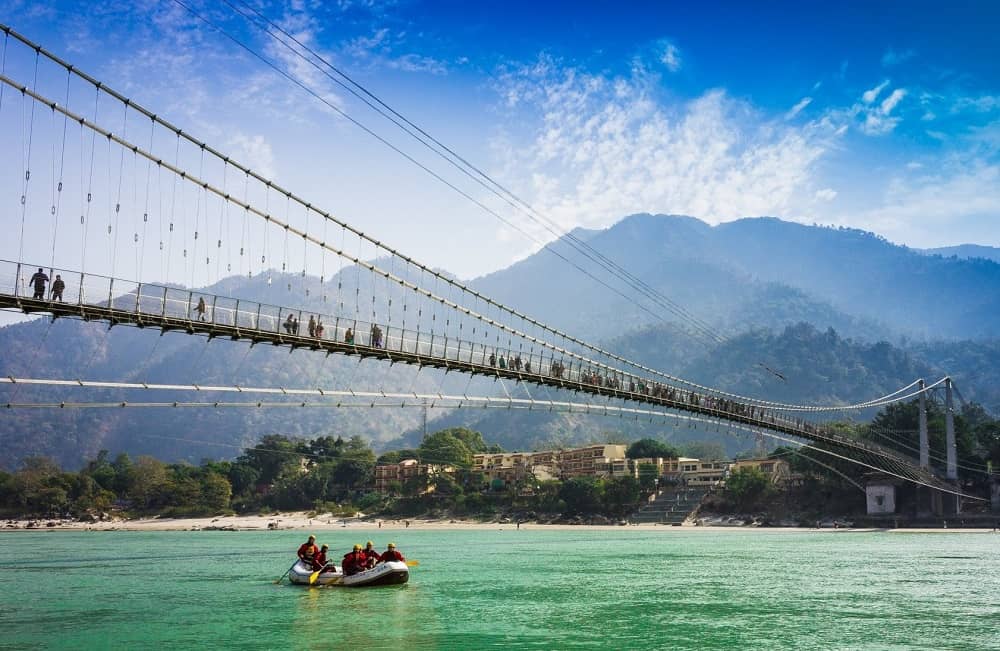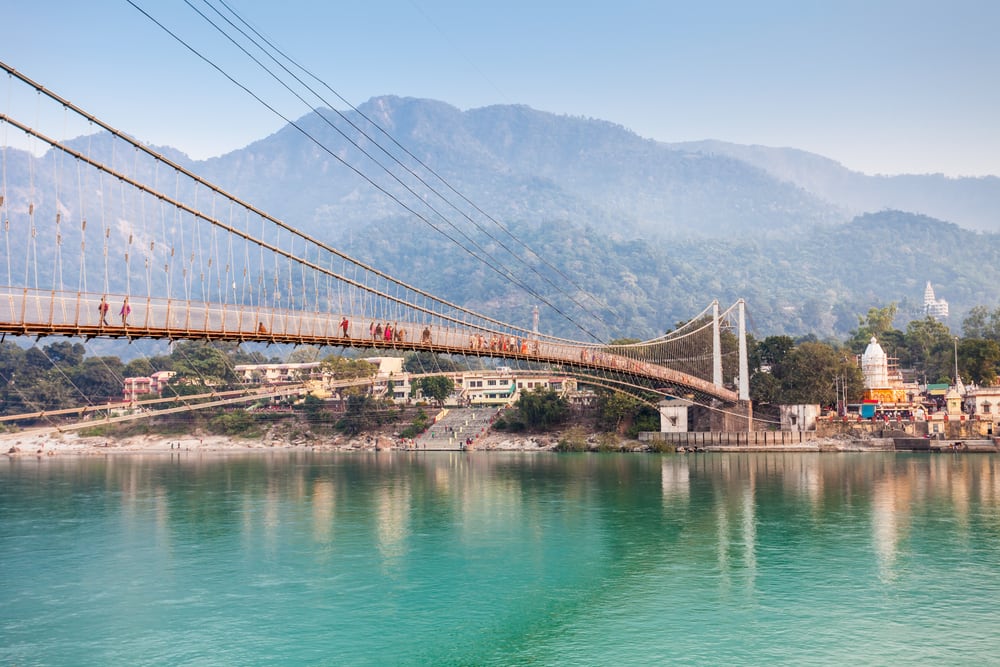Ram Jhula: A Symbol of Spirituality and Engineering Marvel
Introduction
Ram Jhula is an iconic suspension bridge located in Rishikesh, Uttarakhand, India. Spanning the holy Ganges River, it connects the two prominent spiritual hubs—Swarg Ashram and Sivananda Ashram. This architectural marvel is not just a means of transportation but also a landmark of immense cultural, religious, and historical significance. Over the years, it has become a major tourist attraction, drawing visitors from around the world who seek peace, spirituality, and adventure.
Historical Background
Ram Jhula was constructed in 1986, following the footsteps of its predecessor, Lakshman Jhula. While Lakshman Jhula was built in 1929, Ram Jhula was established as an additional passage to accommodate the growing number of pilgrims and tourists visiting the region. The bridge is named after Lord Rama, one of the most revered deities in Hinduism. According to local beliefs, the bridge marks a region where Lord Rama, along with his brother Lakshman, is said to have walked during their exile.
Architectural Features
Ram Jhula is a suspension bridge made of iron, measuring approximately 230 meters (750 feet) in length. It stands at a height that offers breathtaking views of the Ganges and the surrounding Himalayan foothills. The bridge is supported by strong cables and pillars, ensuring its durability against the natural forces of the river and climate. Designed primarily for pedestrians, the bridge also accommodates bicycles and motorbikes, making it a crucial link between the two banks of the river.
The bridge’s engineering is a testament to modern advancements blended with traditional aesthetics. Despite being a relatively new structure compared to other historical bridges, it has maintained its stability and functionality over the years. The gentle swaying of the bridge due to wind and movement adds a unique thrill to crossing it, making it a favorite among adventurers and devotees alike.

Religious and Cultural Significance
Rishikesh, often referred to as the ‘Yoga Capital of the World,’ is known for its deep spiritual roots. Ram Jhula serves as a crucial link between various ashrams, temples, and spiritual centers on either side of the river. Some of the most renowned ashrams in the vicinity include Parmarth Niketan, Swarg Ashram, and Sivananda Ashram, all of which attract thousands of devotees, yoga practitioners, and spiritual seekers every year.
Hindu mythology and religious beliefs are deeply intertwined with Ram Jhula. Many pilgrims consider crossing the bridge a sacred act, believing that it brings them closer to spiritual enlightenment. The Ganges River, flowing beneath the bridge, is regarded as the holiest river in Hinduism, and devotees often perform rituals, prayers, and aarti along its banks.
Tourist Attraction and Activities
Apart from its spiritual significance, Ram Jhula is a major tourist attraction. Visitors can enjoy picturesque views of the Himalayas and the river, making it a popular spot for photography and meditation. The evening Ganga Aarti, held at Parmarth Niketan, is a mesmerizing experience that attracts tourists from all over the world.
Adventurers and thrill-seekers also find the area appealing. The bridge serves as a gateway to activities such as white-water rafting, trekking, and yoga retreats. Rishikesh is known for its vibrant markets where visitors can purchase spiritual books, yoga accessories, gemstones, and handcrafted souvenirs. The local eateries and cafes near Ram Jhula offer delicious vegetarian food, catering to the dietary preferences of spiritual seekers.
Economic and Social Impact
Ram Jhula has significantly contributed to the local economy by boosting tourism and trade. The numerous shops, cafes, and guesthouses on both sides of the river cater to the needs of travelers, generating employment opportunities for locals. The presence of ashrams and yoga centers has also led to the growth of wellness tourism, attracting international visitors seeking spiritual rejuvenation.
Additionally, the bridge has enhanced connectivity between key locations in Rishikesh, making it easier for residents and pilgrims to commute. The seamless movement facilitated by Ram Jhula has played a crucial role in the city’s development while preserving its rich spiritual heritage.

Nearby Attractions
Beyond Ram Jhula, Rishikesh is home to several other fascinating attractions that visitors can explore:
- Lakshman Jhula – Another famous suspension bridge located a few kilometers upstream, associated with the legend of Lakshman crossing the Ganges using a jute rope.
- Parmarth Niketan Ashram – A globally recognized spiritual center offering yoga programs, meditation retreats, and the enchanting Ganga Aarti every evening.
- Triveni Ghat – A sacred bathing ghat where pilgrims gather for holy dips, rituals, and the mesmerizing evening Aarti.
- Neelkanth Mahadev Temple – A revered Hindu temple dedicated to Lord Shiva, located amidst scenic mountains and forests.
- Beatles Ashram (Chaurasi Kutia) – A historical site where The Beatles stayed in the 1960s to practice Transcendental Meditation, now a serene place for meditation and exploration.
- Rajaji National Park – A wildlife sanctuary near Rishikesh, home to elephants, tigers, leopards, and various bird species, ideal for nature lovers and wildlife enthusiasts.
- Kunjapuri Devi Temple – A hilltop temple offering panoramic views of the Himalayas and a popular spot for sunrise treks.
For more information about nearby attractions you can visit : click here
Challenges and Conservation Efforts
Over the years, Ram Jhula has faced several challenges, including overcrowding, wear and tear, and environmental concerns. The bridge witnesses heavy foot traffic daily, and the increasing number of visitors poses a threat to its structural integrity. Regular maintenance and safety checks are conducted to ensure its stability, but continuous monitoring is essential.
Environmental concerns, particularly pollution in the Ganges, have prompted various conservation efforts. Organizations and local authorities are working towards keeping the river clean and preserving the natural beauty of Rishikesh. Pilgrims and tourists are encouraged to follow eco-friendly practices, such as avoiding plastic waste and participating in cleanliness drives.
Frequently Asked Questions (FAQ)
1. Where is Ram Jhula located?
Ram Jhula is located in Rishikesh, Uttarakhand, India, spanning the Ganges River and connecting Swarg Ashram with Sivananda Ashram.
2. What is the length of Ram Jhula?
Ram Jhula is approximately 230 meters (750 feet) long.
3. When was Ram Jhula built?
Ram Jhula was constructed in 1986 to provide additional connectivity for pilgrims and tourists.
4. Is there any entry fee for crossing Ram Jhula?
No, there is no entry fee for crossing Ram Jhula. It is open to pedestrians, cyclists, and two-wheelers.
5. What are the nearby attractions to visit?
Some nearby attractions include:
- Lakshman Jhula
- Parmarth Niketan Ashram
- Triveni Ghat
- Neelkanth Mahadev Temple
- Beatles Ashram (Chaurasi Kutia)
- Rajaji National Park
- Kunjapuri Devi Temple
6. Can vehicles cross Ram Jhula?
Only bicycles and two-wheelers are allowed on the bridge. Four-wheelers are not permitted.
7. What is the best time to visit Ram Jhula?
The best time to visit is between September and April when the weather is pleasant for sightseeing and outdoor activities.
8. Is photography allowed on the bridge?
Yes, photography is allowed and highly recommended as Ram Jhula offers stunning views of the river and the surrounding landscape.
9. How can I reach Ram Jhula?
Ram Jhula is easily accessible from Rishikesh city center via auto-rickshaws, taxis, and walking trails. The nearest railway station is Rishikesh Railway Station, and the nearest airport is Jolly Grant Airport in Dehradun.
10. What activities can be enjoyed near Ram Jhula?
Visitors can enjoy:
- Ganga Aarti at Parmarth Niketan
- River rafting
- Trekking
- Yoga and meditation retreats
- Shopping at local markets
Conclusion
Ram Jhula is more than just a bridge—it is a symbol of spirituality, tradition, and modern engineering. Its presence enhances the religious and cultural essence of Rishikesh, making it a focal point for devotees, tourists, and adventurers alike. As one walks across the bridge, the serene view of the Ganges, the chanting of mantras, and the sight of sadhus in meditation create an atmosphere of profound peace and divinity.
Despite challenges, efforts are being made to preserve the legacy of Ram Jhula for future generations. Whether one visits for spiritual fulfillment, adventure, or simply to witness the beauty of nature, Ram Jhula stands as a timeless gateway to the divine experience that Rishikesh offers. It remains a bridge not just between two shores, but between faith, culture, and the eternal flow of life along the sacred Ganges.



Leave a Reply